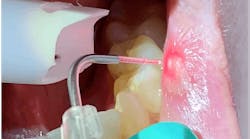The Centers for Disease Control (CDC) says that almost 50% of adults over 30 have gum disease. That number jumps to over 70% once you hit 65. So it’s highly likely that even if you don’t think you have gum disease, you might.
When we think of disease, we often think of pain. But like many diseases, you don’t feel gum disease until it’s very advanced. For far too long, we in the dental industry have neglected our role in educating patients about the health of their gums. We got stuck in the flossing lecture and threw up our hands when you didn’t comply.
But listen up: healthy gums don't bleed.
And when I say don’t bleed, I mean not at all, even when the hygienist is poking at them. Gum disease is a big deal, too. There is lots of science that connects the health of your gums to the health of your body and vice versa. Bleeding gums can contribute to diabetes, arthritis, heart disease, obesity, certain cancers, stroke, high blood pressure, preterm pregnancy, erectile dysfunction, Alzheimer’s disease, and lung disease. This list keeps growing, and science continues to study this connection.
How do you know if you have gum disease?
You might already be thinking about that pink in the sink you see when brushing. At minimum, that could be gingivitis, the earliest stage of gum disease. Or it could have already progressed to periodontal disease.
If you’re feeling all proud because you don’t see bleeding at home, hang on. Just because you don’t see bleeding when you brush doesn’t mean you’re in the clear. Your dental hygienist is the one to ask. If you’re familiar with the part of your appointment when the hygienist calls out all the numbers as they measure the space between your tooth and your gum (you know, the place where the popcorn shells like to go), that’s a great start. We usually say between 1mm to 3mm is healthy, and higher than that could be cause for concern.
More "Dear Patient" by Amanda Hill:
How do you know if your dentist is any good?
6 tips to up your dental home care game
But it’s not just about the numbers. How does your tissue react when we measure? Is there bleeding? Or even pus? Or do you already have recession, and a once healthy three isn’t looking so healthy anymore?
This is hard to admit, but we hygienists haven’t always been good about tracking bleeding spots or, even worse, telling you about it. There are a million excuses—time, fear of conflict, lack of support from the dentist to name a few. But it’s time you advocate for yourself. Ask if there was ANY bleeding while your dental team evaluated your gums or when cleaning your teeth, and if so, where.
Don’t brush it off
If there are areas of concern, talk to your dental team about what they recommend. The more ways you can find to disrupt that bacteria, the better. And no, that doesn’t have to be flossing. There are all kinds of cool picks and brushes that can get between your teeth. But it might take more than that. Your issue could require some advanced instrumentation to really get deep in the pockets, or you coming in to see the hygienist more often.
If that’s not enough, we have even more tricks up our scrubs. We can test your saliva to see what bacteria you’re fighting or use trays filled with a hydrogen peroxide gel that will go under your gums to kill bacteria…or a list of other treatments.
The important thing here is not to brush it off, even if your mama and your grandmama had bleeding gums and you think it’s normal. I’m here to tell you it’s not, and that we need to get to the root of the problem and help you confidently say you don’t have gum disease.







